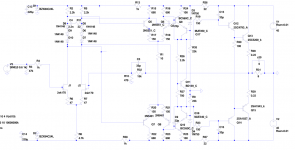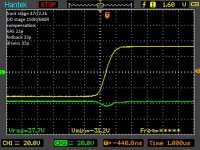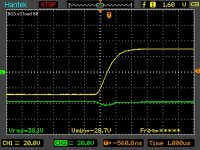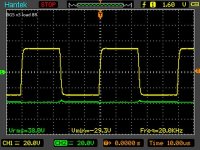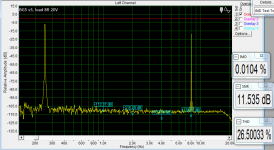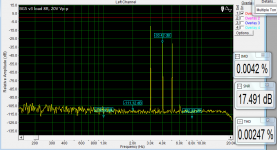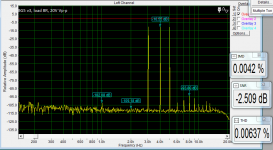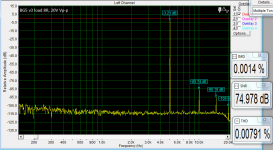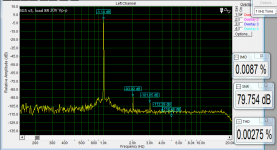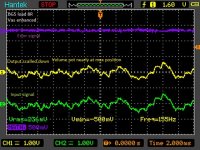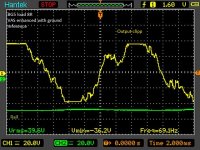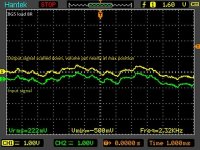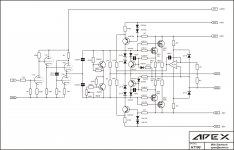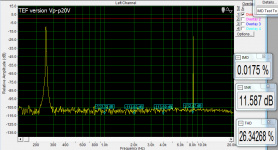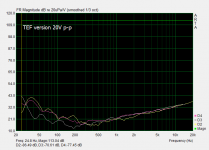I have upgraded slightly my previous board to single j-fet input.
Config:
-j-fet input (47R/2.2k) around 4mA total
-DD (150R/680R) 5mA
-vas cascode (standard not enhanced) 9mA
-darlington output 150mA
Mile if you can take a close look and tell me which area will need improvement please.
Maybe higher freq thd needs some ??
Can you post schematic with compensations?
Today another day of hard work.
I have changed config a small bit:
-input stage 220R/2.2k
-DD stage 22R/680R
-VAS compensation 10p each, feedback 33p, drivers 33p.
The clipping issues are gone!! So in next few days I will do the cosmetics on the amp only. The harmonics spectrum is OK (I think). I am missing higher order harmonics --> would be recommended to have a small amount of 4th and 5th harmonics too ?
Bellow results. The previous version SR is on the last scope reading.
I have changed config a small bit:
-input stage 220R/2.2k
-DD stage 22R/680R
-VAS compensation 10p each, feedback 33p, drivers 33p.
The clipping issues are gone!! So in next few days I will do the cosmetics on the amp only. The harmonics spectrum is OK (I think). I am missing higher order harmonics --> would be recommended to have a small amount of 4th and 5th harmonics too ?
Bellow results. The previous version SR is on the last scope reading.
Attachments
Last edited:
Today another day of hard work.
I have changed config a small bit:
-input stage 220R/2.2k
-DD stage 22R/680R
-VAS compensation 10p each, feedback 33p, drivers 33p.
The clipping issues are gone!! So in next few days I will do the cosmetics on the amp only. The harmonics spectrum is OK (I think). I am missing higher order harmonics --> would be recommended to have a small amount of 4th and 5th harmonics too ?
Bellow results. The previous version SR is on the last scope reading.
Nice results, SR over 20V/us is ok for me.
Regards
last 3 plots.
What is the green channel measuring?
What is the scale of the green channel?
Green channel is rail, same scale 20V
AndrewT
This is another case to check.
There is no rail capacitors on amp board at all. Only psu has decoupling caps, diodes and rc circuits. This problem is not presend on different amp boards.
Only at full amplitude the voltage is pumped between rails.
This is another case to check.
There is no rail capacitors on amp board at all. Only psu has decoupling caps, diodes and rc circuits. This problem is not presend on different amp boards.
Only at full amplitude the voltage is pumped between rails.
Today I have done some real life tests. Bellow results.
The amp is not efficient, clipps very early.
Try it without cascode VAS
Try it without cascode VAS
With cascode in VAS you need +/-10V higer VAS rail than output rails
OnAudio
My learning process is going slowly but forward i think. I have another few amp ideas but I do not know if there will be enough of stamina to build them heh
apexaudio
I have one prototype with TEF atatched to single transistor vas so will try it.
I will prapobly make 2-3 output stages on separate boards to speed up the work 😛
THX
My learning process is going slowly but forward i think. I have another few amp ideas but I do not know if there will be enough of stamina to build them heh
apexaudio
I have one prototype with TEF atatched to single transistor vas so will try it.
I will prapobly make 2-3 output stages on separate boards to speed up the work 😛
THX
I have one prototype with TEF atatched to single transistor vas so will try it.
I will prapobly make 2-3 output stages on separate boards to speed up the work 😛
THX
Or you can made amplifier with separate voltage amp and current amp 🙂
http://www.diyaudio.com/forums/solid-state/164659-tube-mosfet-100w-hybrid-amplifier-7.html
Attachments
Last edited:
Mile
Give me more ideas and I will have to work for next 100 yeares heh
I would do prapobly the dual boostraped vas at first, it is simple and efficient solution, as I did it before it was swinging nearly from rail to rail.
Give me more ideas and I will have to work for next 100 yeares heh
I would do prapobly the dual boostraped vas at first, it is simple and efficient solution, as I did it before it was swinging nearly from rail to rail.
Mile
Give me more ideas and I will have to work for next 100 yeares heh
I would do prapobly the dual boostraped vas at first, it is simple and efficient solution, as I did it before it was swinging nearly from rail to rail.
But diy is hoby and you can work what you like and whan you like 🙂
This design and the design of the first both images of post #7 is basically the same design than those from Ayre (Charles Hansen). Also the french company Cairn-EZO and some other prefer this design, which provides a high open loop gain.Idea for full symmetrical amplifier...
I call this design "mirror symmetry" (my derogative but at the same time true term is error symmetry) or "full true complementary" but both is probably wrong.
Therefore two questions in this matter:
1) which colloquial term for this topology is in the United States usual?
2) what is from your view the audible benefit by listening tests compare to the versions without complementary parts for the LTP and VAS?
This design and the design of the first both images of post #7 is basically the same design than those from Ayre (Charles Hansen). Also the french company Cairn-EZO and some other prefer this design, which provides a high open loop gain.
I call this design "mirror symmetry" (my derogative but at the same time true term is error symmetry) or "full true complementary" but both is probably wrong.
Therefore two questions in this matter:
1) which colloquial term for this topology is in the United States usual?
2) what is from your view the audible benefit by listening tests compare to the versions without complementary parts for the LTP and VAS?
This company is unknown for me, can you post schematics?
Unfortunately there are no genuine schematics released. From the power amp section of the 4808 aboutThis company is unknown for me, can you post schematics?
Cairn 4808 North Face Integrated Amplifier (Used)
and
Cairn Nanda & K1 [English]
and
CAIRN ,,4808 | Flickr - Photo Sharing!
you will find an own drawed schema from me.
Attachments
Last edited:
Heh
If you still have not enough of pictures there you go, bellow TEF version vith single transistor VAS (quick setup on bread board).
I was listening the amp whole day and there is quite big difference between cascode vas version (on the measurements too). This is quick setup made in 15min so prapobly can be improved a bit.
Cacoded version:
-more soft in sound, delicate and bit hidden top octave in compare to TEF version
-bas is more punchy and is lighter than TEF version
-very neutral in sound
TEF one:
-more exposed top octave with sharper edges
-bas has good kick but is hevier than cascode version,
-more ''rock'' sounding amp.
tiefbassuebertr
The amp You have posted is very different to DD stage from sansui.
There is plenty amps using two LTP's as input pair but not many of them are using two floating LTP's as second stage.
If you still have not enough of pictures there you go, bellow TEF version vith single transistor VAS (quick setup on bread board).
I was listening the amp whole day and there is quite big difference between cascode vas version (on the measurements too). This is quick setup made in 15min so prapobly can be improved a bit.
Cacoded version:
-more soft in sound, delicate and bit hidden top octave in compare to TEF version
-bas is more punchy and is lighter than TEF version
-very neutral in sound
TEF one:
-more exposed top octave with sharper edges
-bas has good kick but is hevier than cascode version,
-more ''rock'' sounding amp.
tiefbassuebertr
The amp You have posted is very different to DD stage from sansui.
There is plenty amps using two LTP's as input pair but not many of them are using two floating LTP's as second stage.
Attachments
Last edited:
- Home
- Amplifiers
- Solid State
- Diamond Differential Amplifier
